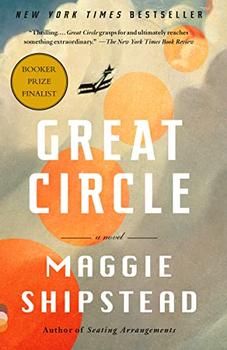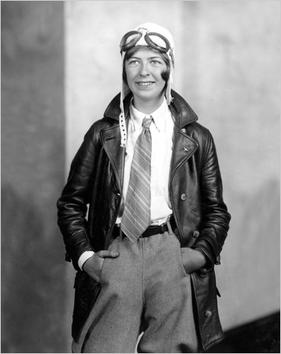Summary | Excerpt | Reading Guide | Reviews | Beyond the Book | Read-Alikes | Genres & Themes | Author Bio

This article relates to Great Circle
 Great Circle features an account of a fictional early aviatrix named Marian Graves, and author Maggie Shipstead inserts snippets of aviation history throughout the narrative. One woman frequently mentioned is Elinor Smith, aka "The Flying Flapper of Freeport."
Great Circle features an account of a fictional early aviatrix named Marian Graves, and author Maggie Shipstead inserts snippets of aviation history throughout the narrative. One woman frequently mentioned is Elinor Smith, aka "The Flying Flapper of Freeport."
Elinor Regina Patricia Ward was born in New York City in 1911 to parents who were in the entertainment industry. Her mother was a singer before her marriage, while her father, Tom Ward, was a successful comedian, singer and dancer on the vaudeville circuit. He later changed the family's surname to Smith and toured Great Britain and France as the Scarecrow in a stage production of The Wizard of Oz.
Tom Smith also loved flying, and exposed his children, Elinor and Joe, to airplanes when they were quite young; Elinor took her first flight at the age of six and was immediately hooked. Tom purchased a Waco 9 biplane, and recognizing Elinor's passion for flying, he allowed his daughter to take lessons. She was so small that her instructor had to attach blocks to the rudder pedals so she could reach them. Tom forbade her from taking off and landing the aircraft, concerned the moves would be too dangerous for her, but Elinor's mother granted permission while her father was out of town. She took her first solo flight in 1926 at the age of 15, and a year later became the youngest pilot in the world to be granted a license (which was signed by Orville Wright).
Elinor rose to public notice as the result of a dare that took place in 1928: Another pilot bet that she couldn't fly under the four bridges along New York's East River. She decided to take him up on the challenge, and after scouting the layout from above she performed the stunt, dodging ships as she flew beneath the structures. Other pilots were aware of the date and time of the attempt, and created a betting pool. Concerned that they'd somehow be tricked, they convinced a newsreel team to have cameras set up under all four bridges to ensure Elinor truly was at the controls. Consequently, this flight was well-documented and made her famous. The New York Department of Commerce wanted to suspend her license afterwards, but Mayor James J. Walker intervened, deciding to punish her by grounding her for 10 days instead. The Department of Commerce issued a letter of reprimand, but enclosed with the document was a request for her autograph so it's hard to believe the censure was meant to be taken seriously.
From 1928 to 1940, Elinor set multiple aviation records and was named the best female pilot of 1930 by her peers, beating out the better-known Amelia Earhart. In addition to the light plane altitude record (11,889 feet) and the woman's speed record (190.8 MPH), both achieved in 1928 when she was just 17 years old, she set the woman's solo endurance record of 13 hours, 16 minutes on a 0° F (−18° C) day in January. Her aircraft was an open cockpit Brunner Winkle biplane, and by the end of the flight she had to be helped out of it because she was nearly hypothermic. In addition, she intended to land in the morning since she'd never performed a night landing. Just in case she couldn't hold out that long, she equipped herself with a flare gun which, if fired, was supposed to alert those on the ground to light up the landing strip. She did have to land at night, and no one saw the flare gun signal, so the field remained pitch black. Fortunately, fellow pilot and future military general Jimmy Doolittle realized what was happening and landed ahead of her, giving her enough information to successfully make it to the ground.
She also had her share of close shaves, probably the most frightening of which occurred in March 1931 during an attempt to set a new altitude record. Her plane's engine died at 26,000 feet, probably from a frozen fuel line, and she lost consciousness while trying to restart it. The plane went into a steep, uncontrolled dive; fortunately, she came to at about 6,000 feet and managed to keep the plane from pancaking into the ground.
Elinor was subsequently hired by the Irving Parachute Company as a pilot for parachute teams giving demonstrations at air shows, thereby becoming the first female executive pilot (a pilot employed by a private business). Later, she became the first female test pilot for both Fairchild Aviation and Bellanca. Her post-flight interviews were so articulate that she was hired by NBC in 1930 as a radio commentator covering aviation stories, a post she held for six years. She also performed stunts at fundraising events and in 1934 became the first woman (and the third person overall) to be pictured on the front of a Wheaties box.
The aviatrix married New York lawyer and politician Patrick Sullivan and took a hiatus from flying in 1940 to raise their four children, resuming after his death in 1956. In 2000 at the age of 88 she became the oldest individual to successfully complete a simulated shuttle landing, and a year later she took her last flight, piloting an experimental plane out of Langley Air Force Base. Elinor died in Palo Alto, California, on March 19, 2010 at the age of 98.
Elinor Smith, 1942
Filed under People, Eras & Events
![]() This "beyond the book article" relates to Great Circle. It originally ran in July 2021 and has been updated for the
April 2022 paperback edition.
Go to magazine.
This "beyond the book article" relates to Great Circle. It originally ran in July 2021 and has been updated for the
April 2022 paperback edition.
Go to magazine.
It was one of the worst speeches I ever heard ... when a simple apology was all that was required.
Click Here to find out who said this, as well as discovering other famous literary quotes!
Your guide toexceptional books
BookBrowse seeks out and recommends the best in contemporary fiction and nonfiction—books that not only engage and entertain but also deepen our understanding of ourselves and the world around us.